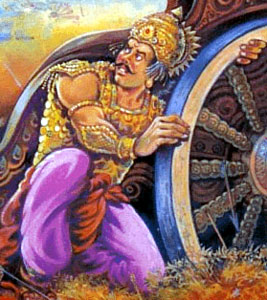 The Kurmanivesa section of the Markandeya Purana has mentioned a tribe called Kulatas, and another named Kurutas. Both seem to be results of confusion with the well-known tribe or people known in history as the Kulutas. The Karna Parva of the Mahabharata refers to the latter which seems to be identical with the Koluta or Koluka of the Kishkindha Kanda of the Ramayana. Some of the historians have identified the land of the Kulutas with the modern Kulu near the source of the Beas.
The Kurmanivesa section of the Markandeya Purana has mentioned a tribe called Kulatas, and another named Kurutas. Both seem to be results of confusion with the well-known tribe or people known in history as the Kulutas. The Karna Parva of the Mahabharata refers to the latter which seems to be identical with the Koluta or Koluka of the Kishkindha Kanda of the Ramayana. Some of the historians have identified the land of the Kulutas with the modern Kulu near the source of the Beas.
The Kulutas seem to have been a tribal republic. Inscriptions and coins testify to the existence of many such republics even in the days of Scythian invasions, among them the Malavas, Yaudheyas and Arjunayanas were the most important. On the other hand the Audumbaras Kulutas, Kunindas and the Uttamabhadras were only second in importance.
Yuan Chwang, the celebrated Chinese pilgrim had said about the kingdom of the Kulatas that the region was entirely surrounded by mountains. It had a rich soil and yielded regular crops and it had rich vegetation. The climate grew gradually cold and there was little snow. There were in the county twenty Buddhist monasteries with above 1,000 brethren of whom the most were Mahayanists and only a few adhered to the Hinayana school. Besides the Buddhist monasteries there were several deva temples in the region. It has been said that the kingdom of the Kulatas is identical with the present Kangra District.
Another important reference to the Kuluta people is also found in the introduction of Prachandapandava of Rajasekhara wherein the poet has described the victories of Mahipala I of the Pratihara Empire. Mahipala there has been credited with having defeated the Kulutas along with the Muralas, Mekalas, Kalingas, Keralas, Kuntalas and the Ramathas.
This article is a stub. You can enrich by adding more information to it. Send your Write Up to content@indianetzone.com





















